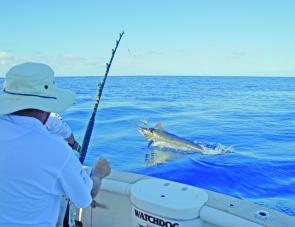This season has already been one dominated by strong winds, tropical low-pressure systems and very warm water. By early January very few small black marlin had shown off the Gold Coast, and most of the fish encountered were bigger blacks from 50-100kg.
There were quite a few dolphinfish early in the season, a few small yellowfin, and not much else. A large tropical low-pressure system wiped out all offshore opportunities from Christmas until well into January, so there has been very little offshore effort early in the season.
February is a great month to troll on the wider grounds targeting bigger blue marlin. With the inshore scene fairly quiet, it seems likely that a lot of local game boats will fish heavy tackle out wide this year, and there have already been a few blues caught, including one monstrous fish lost after 5 hours on heavy tackle. Good areas to troll for blue marlin include Jim’s Mountain, the Tweed Canyons and the slope about four miles east of the northeast 50-fathom reef.
Most boats troll big skirted lures but ‘tease and switch’ is becoming increasingly popular. The average blue marlin is around 120-140kg and on stand up 24kg tackle from a small trailer boat these represent a great challenge. The biggest problem is not getting spooled on the first run. The takeoff is awesome to watch, and the rapid changes in direction demand skilled boat driving.
In closer to shore the Spanish mackerel should start to run this month. This will probably be the last mackerel season where the area east of Couran Cove can be fished legally as it looks destined to be part of the Moreton Bay Marine Park by September 2008 according to the draft plan. Why such a large extensive area of sand that only produces pelagic fish should be listed as part of the zone remains a mystery to me. So if you enjoy trolling this area, fish it this year and then remove it from your future or your kid’s future mackerel spots. This future shut out of anglers seems to lack any credible science and I had no idea how far these zones extended offshore, a distance of over 4km.
Palm Beach and Mermaid reefs should fire up well after the rough seas of early January, and there will probably be a few wahoo around on the 24-fathom line as well by February. Trolling high-speed skirted lures is a good method for both wahoo and Spaniards this month. Anchoring up, berleying and fishing live baits and pilchards is an alternative method.
Bottom fishing is greatly restricted by current this month. There have been a surprising number of quite big snapper caught throughout most of the summer months on both the 24 and 36-fathom lines. A lot of these fish have fallen to jigged soft plastics. A few will be caught in February when the current slows down a bit.
The area just to the north of the Seaway always fishes well in February. There is quite an extensive drop-off north of the big sand bank to the north of the Seaway, and when this holds blue water there is nearly always plenty of bait. These attract mackerel, sharks and cobia. It is a good spot to troll or live bait in calm conditions only.
The estuaries have been fishing very well. Huge schools of white pilchards and anchovies have been in the Seaway for over a month now, and there has been plenty of tailor, big eye trevally and GTs around on the run in tide. There have also been plenty of school mulloway in the Seaway as well when the bait is thick. The best way to fish the Seaway is on a run-in tide early in the morning casting metal lures such as Raiders around the washes near the rock walls. After rough seas some big fish move into the Seaway entrance and it is quite possible to catch Spanish mackerel, cobia, kingies and sharks well inside the wall. February can also produce queenfish and barracuda.
The whiting have been fishing very well lately in the Nerang River, Coombabah Creek and the Pimpama. Wriggler worms are the key to success, but shrimp and small soldier crabs also work very well. Fish light 2-3kg mono and a trace of about 1.5m between the sinker and the hook. Run-in tides fish best. There have been quite a few very good fish to around 700g caught. Quite a few anglers are experimenting with tiny poppers on Gold Coast whiting with mixed results.
Flathead have been quite consistent even through the warmer months. Trolling small hardbodies seems to be out-fishing soft plastics at the moment. Most of the fish are around 40cm but we did manage a beauty of 80cm in Coombabah Creek recently on a trolled Mann’s 5+. Clear water and light south easterlies with a bit of cloud cover generally offer the best fishing.
There will still be a few mangrove jacks around this month. The Coomera and Nerang generally produce well in February on live bait, trolled lures and soft plastics. There have been plenty of jacks over 50cm caught this summer and it is good to see most anglers releasing their catch. Poppers at night are another very reliable method to try.
February is one of the best months to chase pelagics off the Gold Coast, and if we can get reasonable weather hopefully this month should see plenty of marlin, mackerel and wahoo turning up on most of the offshore grounds.
Reads: 1756
This blue marlin was hooked on the game boat Watchdog and put on a great aerial display.




